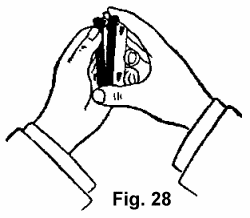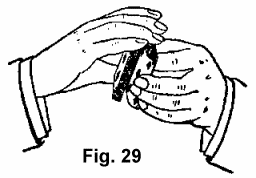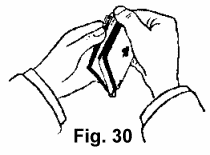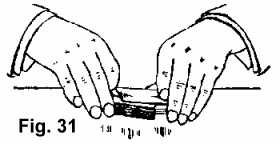THE most ordinary mode of stocking consists in arranging the cards as discreetly as possible while taking tricks, or making the discard, or while gathering up for the deal. There is no sleight of hand in this. A player, if he keeps his wits about him, finds many opportunities during a sitting of prearranging to some extent for his deal. With the aid of a partner of course the possibilities are doubled. But the general understanding is that the whole deck must be tampered with before the shuffle begins. If dalliance with the deck is allowed–and it is amazing how much of that sort of thing is permitted in some games–a practiced operator can run up one or two hands with incredible rapidity, and his actions will appear as mere trifling.

This is done by holding the deck in the left hand, back to palm, with thumb against one side, second, third and little fingers on the other side, and first finger curled up against the back. The right hand now covers the face, fingers at one end, thumb at the other. The left thumb then springs the cards so that the index can be seen. (See Fig. 28.) As a desired card is located, the lower side of the deck is opened at that point, and the left second, third and little fingers inserted, and the card is drawn or slipped out to the top of deck. (See Fig. 29.) Then indifferent cards to the requisite number are slipped from the bottom in the same manner on top of the first selected card. Then the next desired card is located and brought to the top, and so on till the stock; is complete. Little or no skill is required, but a practiced hand can locate and bring the cards to the top in a moment or two and without the least noise.

Two sets of threes for a Poker game may be stocked with but four movements, if the desired cards happen to be separated. Assume the game is five-handed. The dealer glances at the index of the five top cards, or places his own hand on top for the start, and finds, say, Six. Four, Queen, Nine and Eight. He decides to run up three Fours for the second player, and three Eights for himself. He springs the cards until he locates an Eight, then inserts second and third fingers, then springs the next two indifferent cards and inserts the little finger, and slips these three cards to the top. Then he locates a Four and the next indifferent card and brings these to the top. Then the Eight again, with two cards; then the Four with one card, and the stock is complete. It would take an untutored player ten times as long to set up the hands if he had the deck, table and room all to himself.
A more artistic method of locating and securing cards, when the company will stand for dalliance at all, is to jog the desired cards and bring them to the bottom with one movement when about to riffle. It can be accomplished in the following manner:

Hold the deck in the left hand, back to palm, between thumb and fingers, as described for the last process, but in covering the face with the right hand bring the first three fingers straight across the outer end of the deck, the little finger against the lower side at corner and the thumb on top side at corner close to right first finger. Then spring the cards with the left thumb against right thumb. When a desired card is located tilt the packet, then held between the right thumb and little finger, about half an inch outward, so that the right thumb will pass the corner of the packet held by the left hand. (See Fig. 30.) Then release the desired card with the left thumb, press down on its corner with the right thumb and bring the right-hand packet back to its original position, closing up the space entirely. In doing so it will force the desired card down and out against the left- hand fingers. Release these fingers slightly as the packets are being closed, and then press the desired card up again with the left little finger. This will cause it to protrude about half an inch at the end, but it is entirely concealed by the positions of the hands. The deck can now be again sprung rapidly with the left thumb in search of the next card without disturbing the one already jogged, and the procedure be repeated until the required number are jogged in the position of the first. (See last Figure.) When toying with the deck is tolerated, no more innocent-appearing action can be taken. The movements to jog the cards are imperceptible if cleverly executed, and it is quite apparent to an onlooker that the relative positions of the cards are not changed. The fact that the springing is continued after the cards are jogged, and the visible end and the sides of the deck are squared up perfectly before the riffle begins, make it appear to even a suspicious observer that any knowledge of location would be again lost.

When the desired cards are jogged, jog several of the top cards at the same end, concealing their opposite ends with the right fingers, then shift the left thumb and second and third fingers to the inner side corners, and turn the deck face down, shifting the right hand to the top at the opposite side corners in position to make a running cut. Then with the left hand draw off the top packet, sliding out the jogged cards with the same movement, dropping them on the table (see Fig. 31), and make a running cut with the rest of the deck. This leaves the desired cards at the bottom.
There is no difficulty at all in the action of getting out the jogged cards. A firm hold on them is obtained by the left fingers, and they are concealed by the packet coming off the top. If the action of jogging the cards is not suspected the rest is easy and absolutely undetectable. Three or four cards can be located and brought to the bottom in this manner in ten seconds. The blind riffle is at once proceeded with in the usual way to retain bottom stock.
A complete Top Stock may be run up by the last method if the cards chance to be separated. Assuming again that the game is Five-Handed Poker, and say Three of a Kind are desired. When the first card is located the next four indifferent cards are sprung and the five jogged all together with one movement. Then the next card is located, four added and jogged. But when the third card of the Kind is located but two indifferent cards are added. Then when about to riffle, the jogged cards are drawn out as in the last described process, but thrown on top instead of on the table. This action appears like a simple cut. Now the "Top Stock Blind Riffle" is executed twice, which action places two additional cards on top, and these are necessary to complete the Top Stock and give the Three of a Kind to the dealer.
As mentioned, the desired Three must chance to be separated by at least the four cards necessary to go in between them. However, the probabilities are that even Four of a Kind will be found so removed. It is very simple to run up Flushes in this manner, and in nine cases out of ten any suit will be found sufficiently dispersed. It is very easy to count the cards rapidly and accurately, if the position for holding the deck is properly maintained; and the action is the same in running up a stock for any game.
